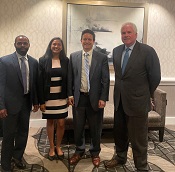
| Archive | Subscribe | Printer Friendly | Send to a Friend | www.agc.org |
|
Federal Government
Inflation Reduction Act ties—for the first time—labor mandates as a condition for receiving tax incentives spurring private construction projects.
On August 7, the U.S. Senate passed along party lines the AGC-opposed Inflation Reduction Act of 2022 (IRA), which for the first time ties prevailing wage and registered apprenticeship requirements as a condition for receiving tax incentives spurring the construction of clean energy projects and energy efficient commercial buildings (179D). To help provide some insight on these new requirements and tax incentives, AGC of America put forth an initial analysis found here. The IRA is expected to pass the U.S. House of Representatives on August 12 with the president signing it into law shortly thereafter. AGC will provide more detailed analysis of this bill soon. For more information, contact Jim Young at jim.young@agc.org.
The Senate voted in line with AGC to overturn the Biden administration’s onerous NEPA rule to restore certainty for the construction industry and the environmental permitting process.
On August 4, the United States Senate approved on a 50-47 vote a joint resolution providing for congressional disapproval of the Biden Administration’s NEPA rule. AGC supports overturning this onerous NEPA regulation because doing so would restore certainty for the construction industry and ensure that infrastructure projects are not needlessly delayed without jeopardizing important environmental protections.
The joint resolution, championed by Senator Dan Sullivan (R-Alaska), included the support of every Republican senator and Sen. Joe Manchin (D-W.Va.). AGC previously reported on the Biden Administration’s NEPA rule, which adds to the regulatory uncertainty coming out of Washington that has created instability and made it harder to plan and manage construction projects. It is disappointing that instead of implementing the environmental review and permitting reforms included in the Bipartisan Infrastructure Law, the administration has instead chosen to add new, vague hurdles to this arduous process.
AGC supports overturning the Biden Administration’s NEPA rule and has included it in its key vote for the education of its members. The joint resolution moves to the House for consideration next. But even if it were to pass there, President Biden would veto it and there would not be two-thirds of both houses of Congress to override his veto.
For more information, contact Alex Etchen at Alex.etchen@agc.org.
Federal Agencies
Begins August 22
On Aug. 22, the Small Business Administration (SBA) final rule will go in effect that will greatly expand the ability for certain small business federal subcontractors to receive past performance ratings for small business joint venture members and small business first-tier subcontractors. Under the new rule, certain first-tier small business subcontractors under prime contracts that include subcontracting plans, can request from the prime contractor a performance rating within 30 days of prime contract’s completion, and requires the prime contractor to provide a rating to those subcontractors within 15 calendar days. SBA did not provide a standard form for primes to use, but requires primes to use the five-scale rating system similar to CPARS (FAR 14.1503): Exceptional, Very Good, Satisfactory, Marginal, and Unsatisfactory. It is unclear how federal agencies will use these rating systems and the final rule does not specify. Additionally, certain small businesses may use the past performance of the joint venture with the small business' offer on a prime contract. The small business must identify: (i) the joint venture; (ii) the contract(s) of the joint venture that the small business elects to use; and (iii) describe to the agency what duties or responsibilities the small business carried out as a joint venture member. For more information, contact Jordan Howard at Jordan.Howard@agc.org or (703) 837-5368.
OSHA’s top officials earnestly engage with AGC contractors to understand the real-world impacts of the agency’s heat hazards National Emphasis Program, including the 80-degree trigger, reduced worker hours to allow for acclimatization, and body temperature and heart rate monitoring.
On July 26, the top OSHA officials—including OSHA head Douglas Parker—met with AGC in conjunction with the association’s Construction Safety, Health & Environmental Conference in Washington, D.C. Robust conversations were held on the regulatory landscape facing construction contractors, including a future OSHA rulemaking on establishing a national heat standard. AGC contractors had the opportunity to impart real-world impacts of OSHA’s National Emphasis Program on Outdoor and Indoor Heat-Related Hazards, including the 80 degree trigger, reduced work days to allow acclimatization for new workers and those returning from vacation, and body temperature and heart rate monitoring.
The conference was especially timely as the U.S. House of Representative’s Education and Labor Committee on July 27 advanced a legislative proposal to require OSHA to issue a national heat standard far earlier than OSHA has said is possible. The legislation, H.R.2193 (Asuncion Valdivia Heat Illness and Fatality Prevention Act of 2021) ignores the significant progress that the industry has taken to address work-related heat exposure, not to mention the recent actions that OSHA has taken with its National Emphasis Program.
The accelerated timeline as proposed in H.R.2193 to finalize a complex and prescriptive standard also jeopardizes the effectiveness and opportunity for stakeholder involvement. The Construction Industry Safety Coalition, of which AGC is a leader, shared these concerns and more with lawmakers. AGC will continue to advocate for sensible workplace safety regulations. The legislation is not expected to become law, but rather pressure OSHA to rush establishing a national heat standard.
Prices of concrete products and some building materials continue to rise, while diesel fuel, asphalt, lumber and some metals fall in month of July
The price of materials and services used in nonresidential construction fell 1.3 percent last month, while contractors’ bid prices rose 5.4 percent, according to an analysis by AGC of America of government data released recently. Association officials noted that, despite the monthly decline, materials prices remain high and the availability of certain key materials erratic. “Contractors welcome any relief they can get in the cost of most construction materials,” said Stephen E. Sandherr, the association’s chief executive officer. “But it is still too hard to acquire most materials and prices remain quite elevated for many key products.”
Upcoming Events
August 16, 2022 August 17, 2022 August 30-September 21, 2022 September 8, 2022 September 9-28, 2022 September 12-30, 2022 September 13-November 1, 2022 September 13, 2022 September 14, 2022 September 25-30, 2022 September 27, 2022 September 28, 2022 AGC News
In this episode, AGC’s own Jimmy Christianson, Vice President of Government Relations, and Deniz Mustafa, Program Coordinator for the Building Division take a dive into what Buy America/n requirements are, why we have them, and what we may be able to expect from new Buy America Build America Act regulations that come with the Infrastructure Investment and Jobs Act. As government agencies work through their individual processes and procedures, AGC would like to prepare members for imminent changes involving material procurement.
Apply by Monday, October 24, 2022!
AGC of America is proud to announce the launch of the 2023 AGC Awards competitions! The Construction Risk Partners Build America Awards (including the Marvin M. Black Partnering Excellence category) and AGC in the Community competitions recognize the nation's most impressive construction projects ranging across the building, highway and transportation, utility infrastructure, and federal and heavy divisions; those contractors excelling in their partnering and collaborative endeavors; and the charitable contractors and chapters giving back to their communities.
The AGC Diversity & Inclusion Excellence Awards recognize contractors that are champions in advancing diversity and inclusion within their workforce, subcontractor-partners, supply chain, the association, and in the communities they serve. The AGC Diverse Business of the Year competition honors an outstanding diverse AGC member-firm that is committed to achieving business success, while also contributing to the association and communities in which they work.
In 2018, AGC of America celebrated 100 years of serving the construction industry. While we celebrated and recognized the past it is important that we continue to look to the future to address ongoing issues affecting the industry. In this spirit, AGC decided to make the Innovation Awards an annual award to incentivize and encourage free thinkers to provide pioneering solutions to industry challenges.
Apply by Monday, October 24, 2022 for full consideration. Learn more about AGC of America's awards programs at www.agc.org/awards.
Deadline to Apply is November 1, 2022
Each year the AGC Education and Research Foundation offers undergraduate and graduate level scholarships to students enrolled in ABET or ACCE accredited construction management or construction related engineering programs. The application opened July 1, 2022 and closes November 1, 2022. Over $10 million in scholarships have been awarded to more than 4,000 students attending colleges and universities across the country. Through endowments made by AGC members and supporters, as well as AGC Chapters, the Education and Research Foundation awards over 100 scholarships each year to students dedicated to pursuing a career in the construction industry. Students can click here to apply. If you have any questions please contact Paige Packard, Program Director, AGC Education and Research Foundation, paige.packard@agc.org.
Association official says labor shortages are keeping the construction sector from adding even more jobs, urges new investments in construction workforce development and training programs
Construction firms added 32,000 jobs in July as the sector's unemployment rate fell to 3.5 percent and the number of unfilled construction positions approaches record levels, according to an analysis of federal employment data released recently by AGC of America. Association officials said the job gains were welcome news but would have been higher if firms could find more workers to hire.
|
||||||||||||||





